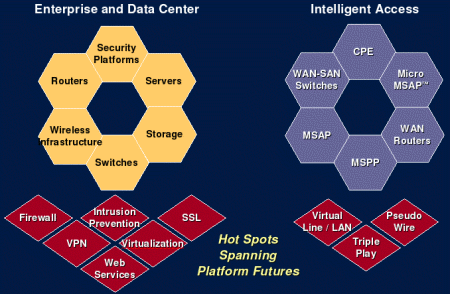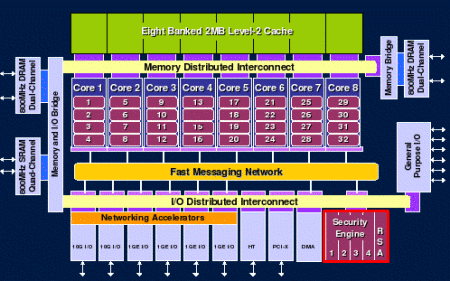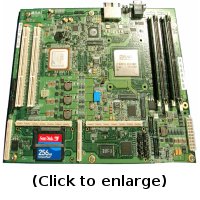Multi-core, multi-threaded chips ship with Linux
May 18, 2005 — by Henry Kingman — from the LinuxDevices Archive — views Raza Microelectronics Inc (RMI) is shipping six high-throughput, multi-core, multi-threaded MIPS64 chips for data center, imaging, and intelligent access point applications. The XLR family of chips clocks up to 1.5GHz, and offers 16-32 thread processing engines. Development boards and Linux BSPs (board support packages) are available.
Raza Microelectronics Inc (RMI) is shipping six high-throughput, multi-core, multi-threaded MIPS64 chips for data center, imaging, and intelligent access point applications. The XLR family of chips clocks up to 1.5GHz, and offers 16-32 thread processing engines. Development boards and Linux BSPs (board support packages) are available.
(Click for larger view of ArizonaATX-II development board)
RMI's XLR chips target integrated security devices, web services, virtualized storage, load balancing, server offload, and intelligent routing and switching devices, the company says.

Target markets for XLR line
Multi-core… AND multi-threaded
RMI notes that the chip market is moving en masse to a multi-core architecture — chip companies that have announced or shipped multi-core chips or chip designs recently include:AMD (AMD64), Sony/IBM/Toshiba (Power), Broadcom (MIPS), PMC-Sierra (MIPS), Freescale (PowerPC), Cavium (MIPS), TI (ARM11/DSP), ARM Ltd. (ARM), NEC (ARM), and Centrality (ARM9/DSP).
However, RMI contends that for I/O-intensive tasks, multi-core chips can still be inefficient, because memory speed increases through the years have not kept pace with processor clock speeds. The company says its multi-threaded, multi-core approach can hide memory latency, because “threading [provides] a simple means to utilize the available processing time [while] waiting for requested data.”
Additionally, RMI says its XLR chips support standard C/C++ programming environments, allowing wire-speed throughputs to be driven by standard software developed using well-understood tools, without the added complexity, cost, and scalability limitations of “proprietary and semi-programmable NPUs, ASICs and co-processors.”

XLR architecture
Additional XLR features touted by RMI include:
- large, sophisticated L2 caches
- full-speed, high-throughput, point-to-point interconnects that support multiple transactions per clock cycle, and can operate at the same frequency as the core
- networking accelerators
- an autonomous security accelerator that can process 10Gbps of bulk cryptography
- interchip messaging complex
- an 8-banked 2MB cache can process up to eight simultaneous requests
- high-performance, low-latency FMN (fast messaging network) optimizes distribution of workloads across processing threads and accelerators
The XLR line
The XLR chips clock up to 1.5GHz, and include four or eight MIPS64 cores, each implementing fine-grained, four-way multi-threading, RMI says. Specific models include:
- XLR308
- three Gigabit Ethernet interfaces
- dual 36-bit DDR1/DDR2/RLD2 DRAM controllers
- 64-bit PCI-X interface
- general purpose I/O
- XLR532, XLR516, XLR508
- four Gigabit Ethernet interfaces
- four 36-bit memory controllers
- HyperTransport interface
- XLR732, XLR716
- all features of XLR5xx series, plus…
- standard LA-1 interface
- two high-speed ports supporting either 10 Gigabit Ethernet (XGMII) or SPI-4.2 interfaces
The last two digits in the product numbers indicate the number of threads. The XLRx32 processors support 32 threads, and 2MB of level-2 cache, while the XLRx16 supports 16 threads and 1MB of level-2 cache. Finally, the XLRx08 processors support eight threads, and 512KB of level-2 cache memory.
Microprocessor Report's editor-in-chief, Kevin Krewell, said, “RMI has raised the bar by delivering 32-way threading, outstanding integration, and innovative scalability which will enable a new generation of throughput-optimized connected systems.”
Raza's chief strategy officer, Aamer Latif, said, “We have created an innovative threaded architecture, with a general purpose programming model, capable of delivering the tremendous throughput and intelligent functionality which, until now, has been unavailable.”
Availability
All XLR chips are shipping, and are distributed with a Linux 2.6 BSP and toolchain. A VxWorks 5.5 BSP is also available from Wind River, Raza says.
 Also available are three evaluation boards:
Also available are three evaluation boards:
- ArizonaATX-1 — an ATX board that supports all XLR chips. Interfaces include:
- dual DDR2 memory slots supporting up to 2GB (2 512MB DDR-533 DIMMs included)
- dual 64-bit 133MHz PCI-X ports
- quad gigabit Ethernet MACs
- QDR SRAM
- dual SPI-4.2 ports
- two serial ports
- I2C bus
- 4-32MB of onboard Flash
- 10 status lights for bring-up
- ArizonaATX-II — an ATX board (pictured at top of page) that supports all XLR chips. Interfaces include:
- Four DDR slots supporting DDR1, DDR2 or RLDRAM memory (2 512MB DDR-533 DIMMs included)
- NSE (network search engine) via LA-1 port
- dual 10Gbps Ethernet ports
- four Gigabit Ethernet ports
- two 64-bit, 100MHz PCI-X slots
- HyperTransport
- dual serial ports
- I2C bus
- 16MB onboard flash
- PCIX-I host bus adapter — a 64-bit, 133MHz PCI-X card with voltage regulation and four 10/100/1000 Ethernet ports. Supports XLR5xx-series processors.
The development boards are available with firmware, Linux OS, cross-development GNU toolchain optimized for XLR, GNU debugger, and debug tool that supports the Corelis Code Runner – XLR JTAG Emulator. RMI says its customers will receive early access to its XLR-specific enhancements to Linux.
RMI is headquartered in Cupertino, Calif., with offices in China, India, and Japan.
This article was originally published on LinuxDevices.com and has been donated to the open source community by QuinStreet Inc. Please visit LinuxToday.com for up-to-date news and articles about Linux and open source.